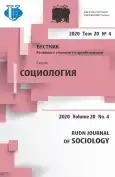Diversity and social cohesion in the United Arab Emirates
- Авторлар: Al Oraimi S.Z.1
-
Мекемелер:
- United Arab Emirates University
- Шығарылым: Том 20, № 4 (2020)
- Беттер: 837-846
- Бөлім: Contemporary society: the urgent issues and prospects for development
- URL: https://journal-vniispk.ru/2313-2272/article/view/322894
- DOI: https://doi.org/10.22363/2313-2272-2020-20-4-837-846
- ID: 322894
Дәйексөз келтіру
Толық мәтін
Аннотация
The article examines the effects of cultural diversity on social cohesion in the United Arab Emirates (UAE). The UAE is an oil-rich country established in 1971 as a federation of seven Emirates. It is a small state with a population of ten million; the citizens account only for 10% of the population. Oil wealth enables the country to achieve advanced levels of human, social and economic development. Recently, the UAE has experienced a massive social change; modernization processes have been impended on highest levels. However, due to the historical demographic structure of the local population, the UAE always depended on external labor forces. Skilled and unskilled male workers immigrate from neighboring countries; as a result, the population structure has changed. After the world economic depression in 2008, the UAE experienced a dramatic increase in the number of population. Professional workers from all over the world flowed to the country, and Dubai became a major center for the regional trade market; today, its free zones are considered the best technical base for service and logistic businesses. Today, more than 200 nationalities live in the country, and the majority of them are migrant male workers. This instable and unbalanced demographic structure created cultural domination - international cultures dominate the local one. The demographic imbalance between citizens and foreigners resulted in a kind of disharmony. Due to their feeling of being a minority, the Emiratis move from the old cities to the suburban areas, which creates many social tensions. All these circumstances affected social cohesion, communal harmony and the direct social interaction of cultural groups. To illustrate the tensions and discomforts in the UAE, the author presents the results of face-to-face interviews and a group discussion - as a critical analysis by those in the center of change.
Авторлар туралы
S. Al Oraimi
United Arab Emirates University
Хат алмасуға жауапты Автор.
Email: s.aloraimi@uaeu.ac.ae
профессор социологии, заведующая кафедрой социального управления
P.O. Box 15551, Al Ain, Abu Dhabi, United Arab EmiratesӘдебиет тізімі
- Al Oraimi S.Z. UAE: Between Instilling Identity and Strengthening Belonging. Emirates Center for Strategic Studies and Research; 2018 (In Arabic).
- D’Appollonia A.C. Migrant Mobilization and Securitization in the US and Europe. How Does It Feel to Be a Threat? Palgrave Macmillan; 2015.
- Freire P. Selections from the Prison Notebooks of Antonio Gramsci. New York; 1970.
- Heywood A. Political Ideas and Concepts: An Introduction. London; 1994.
- Kathiravelu L. Migrant Dubai: Low Wage Workers and the Construction of a Global City. Palgrave Macmillan; 2016.
- Mehta S. This Land Is Our Land: An Immigrant’s Manifesto. Farrar, Straus and Giroux; 2019.
- Mesoudi A. Cultural Evolution: How Darwinian Theory Can Explain Human Culture and Synthesize the Social Sciences. Chicago University Press; 2011.
- Morgan S.P. Is low fertility a twenty-first-century demographic crisis? Demography. 2003; 4.
- Santucci A. Antonio Gramsci. New York; 2010.
Қосымша файлдар









